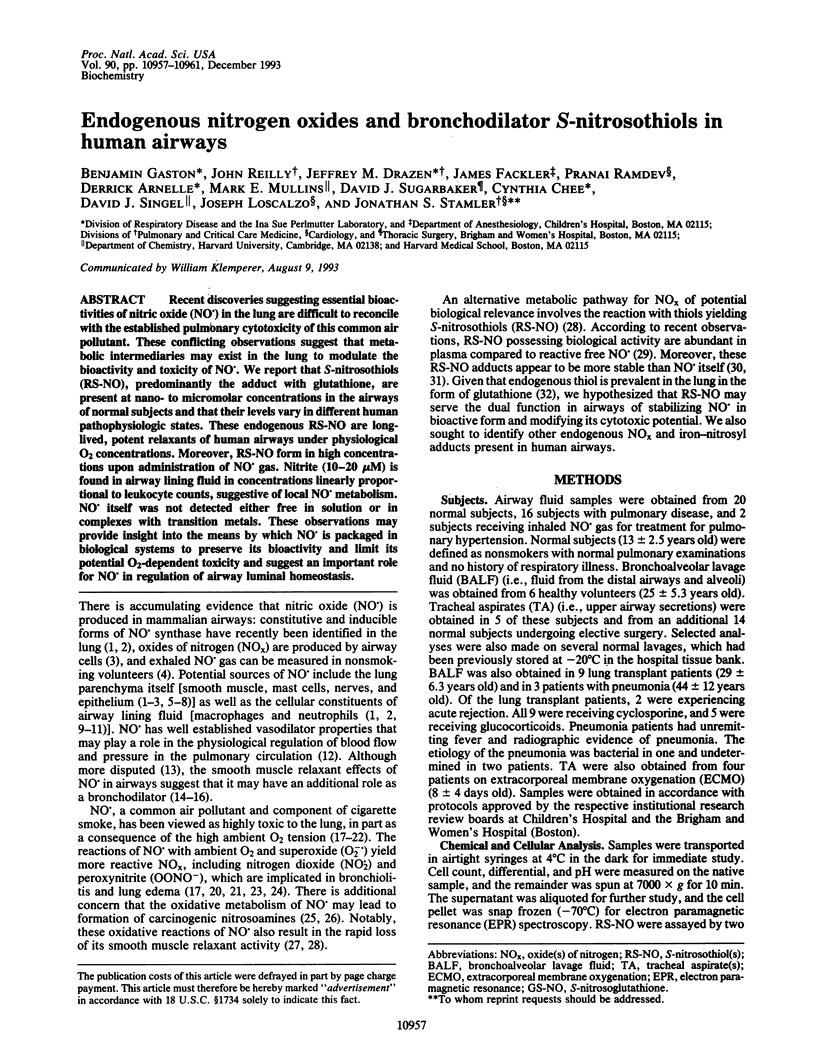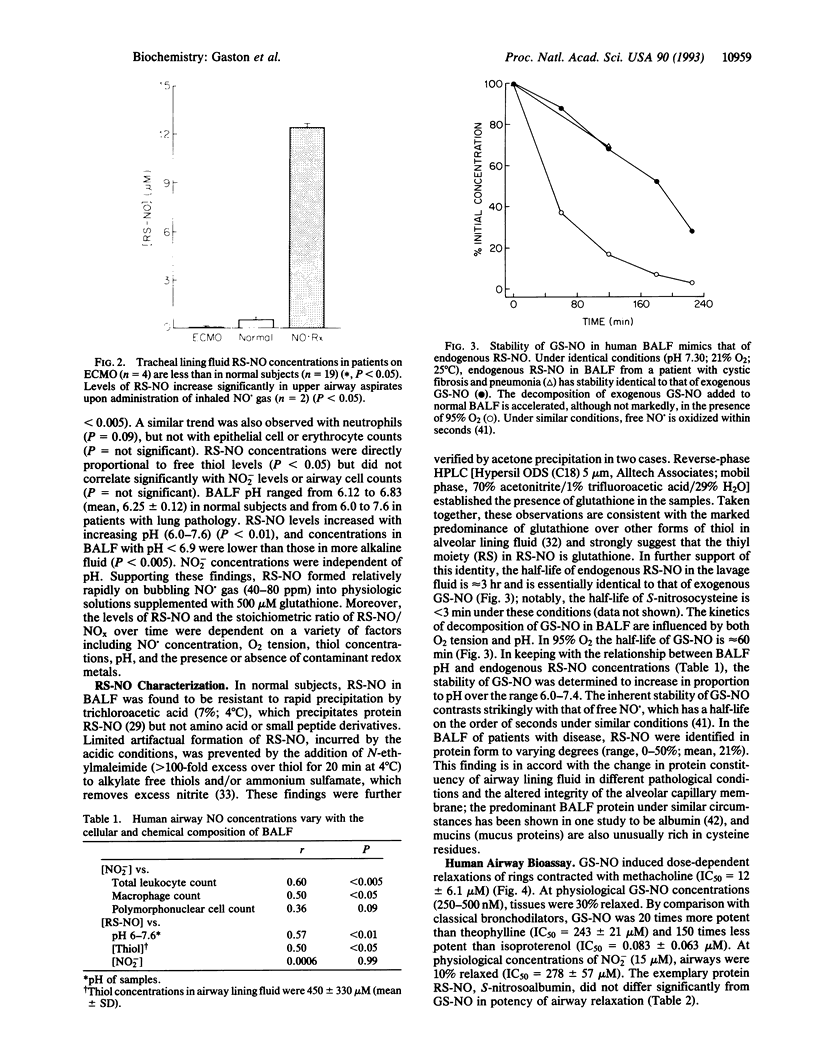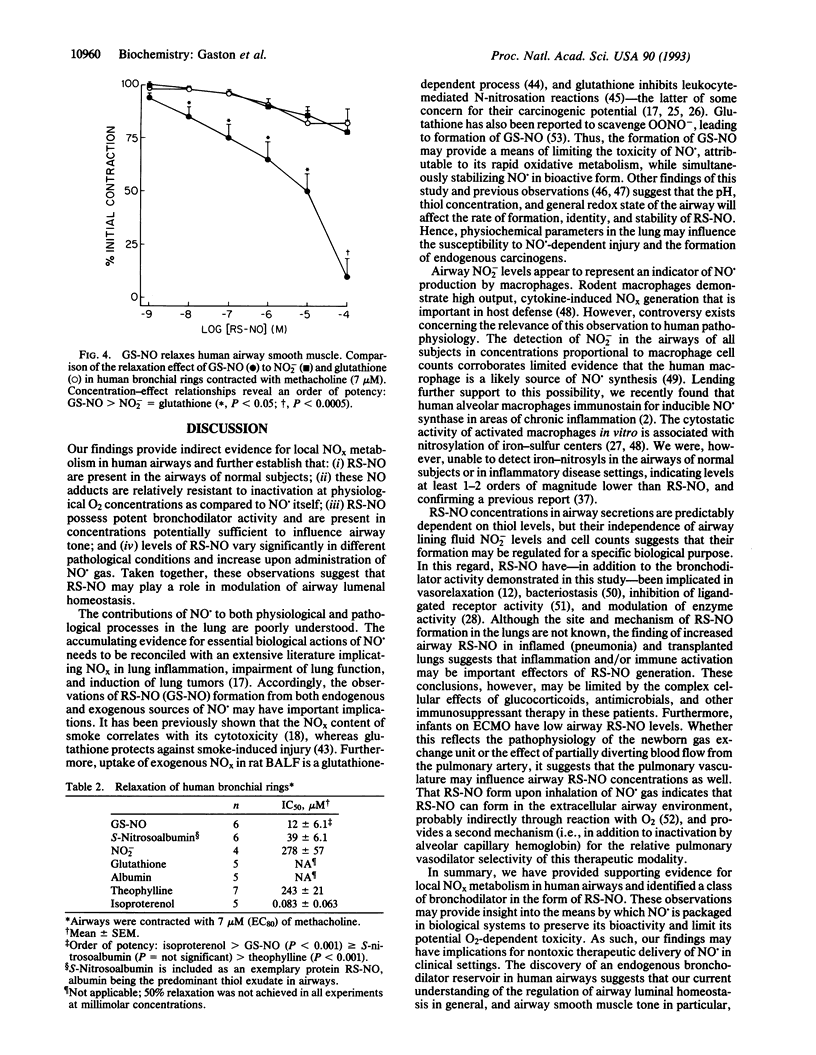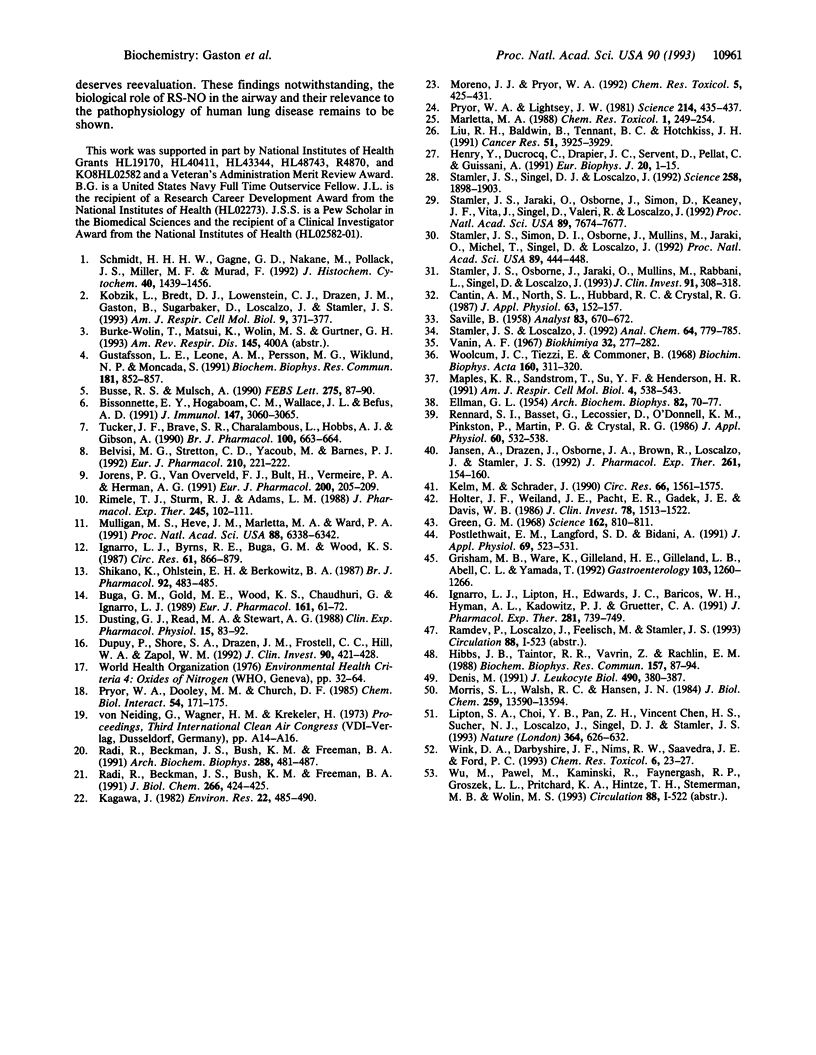Abstract
Recent discoveries suggesting essential bioactivities of nitric oxide (NO.) in the lung are difficult to reconcile with the established pulmonary cytotoxicity of this common air pollutant. These conflicting observations suggest that metabolic intermediaries may exist in the lung to modulate the bioactivity and toxicity of NO.. We report that S-nitrosothiols (RS-NO), predominantly the adduct with glutathione, are present at nano- to micromolar concentrations in the airways of normal subjects and that their levels vary in different human pathophysiologic states. These endogenous RS-NO are long-lived, potent relaxants of human airways under physiological O2 concentrations. Moreover, RS-NO form in high concentrations upon administration of NO. gas. Nitrite (10-20 microM) is found in airway lining fluid in concentrations linearly proportional to leukocyte counts, suggestive of local NO. metabolism. NO. itself was not detected either free in solution or in complexes with transition metals. These observations may provide insight into the means by which NO. is packaged in biological systems to preserve its bioactivity and limit its potential O2-dependent toxicity and suggest an important role for NO. in regulation of airway luminal homeostasis.
Full text
PDF




Selected References
These references are in PubMed. This may not be the complete list of references from this article.
- Belvisi M. G., Stretton C. D., Yacoub M., Barnes P. J. Nitric oxide is the endogenous neurotransmitter of bronchodilator nerves in humans. Eur J Pharmacol. 1992 Jan 14;210(2):221–222. doi: 10.1016/0014-2999(92)90676-u. [DOI] [PubMed] [Google Scholar]
- Bissonnette E. Y., Hogaboam C. M., Wallace J. L., Befus A. D. Potentiation of tumor necrosis factor-alpha-mediated cytotoxicity of mast cells by their production of nitric oxide. J Immunol. 1991 Nov 1;147(9):3060–3065. [PubMed] [Google Scholar]
- Buga G. M., Gold M. E., Wood K. S., Chaudhuri G., Ignarro L. J. Endothelium-derived nitric oxide relaxes nonvascular smooth muscle. Eur J Pharmacol. 1989 Feb 14;161(1):61–72. doi: 10.1016/0014-2999(89)90180-5. [DOI] [PubMed] [Google Scholar]
- Busse R., Mülsch A. Induction of nitric oxide synthase by cytokines in vascular smooth muscle cells. FEBS Lett. 1990 Nov 26;275(1-2):87–90. doi: 10.1016/0014-5793(90)81445-t. [DOI] [PubMed] [Google Scholar]
- Cantin A. M., North S. L., Hubbard R. C., Crystal R. G. Normal alveolar epithelial lining fluid contains high levels of glutathione. J Appl Physiol (1985) 1987 Jul;63(1):152–157. doi: 10.1152/jappl.1987.63.1.152. [DOI] [PubMed] [Google Scholar]
- Denis M. Tumor necrosis factor and granulocyte macrophage-colony stimulating factor stimulate human macrophages to restrict growth of virulent Mycobacterium avium and to kill avirulent M. avium: killing effector mechanism depends on the generation of reactive nitrogen intermediates. J Leukoc Biol. 1991 Apr;49(4):380–387. doi: 10.1002/jlb.49.4.380. [DOI] [PubMed] [Google Scholar]
- Dupuy P. M., Shore S. A., Drazen J. M., Frostell C., Hill W. A., Zapol W. M. Bronchodilator action of inhaled nitric oxide in guinea pigs. J Clin Invest. 1992 Aug;90(2):421–428. doi: 10.1172/JCI115877. [DOI] [PMC free article] [PubMed] [Google Scholar]
- Dusting G. J., Read M. A., Stewart A. G. Endothelium-derived relaxing factor released from cultured cells: differentiation from nitric oxide. Clin Exp Pharmacol Physiol. 1988 Feb;15(2):83–92. doi: 10.1111/j.1440-1681.1988.tb01049.x. [DOI] [PubMed] [Google Scholar]
- ELLMAN G. L. Tissue sulfhydryl groups. Arch Biochem Biophys. 1959 May;82(1):70–77. doi: 10.1016/0003-9861(59)90090-6. [DOI] [PubMed] [Google Scholar]
- Green G. M. Cigarette smoke: protection of alveolar macrophages by glutathione and cysteine. Science. 1968 Nov 15;162(3855):810–811. doi: 10.1126/science.162.3855.810. [DOI] [PubMed] [Google Scholar]
- Grisham M. B., Ware K., Gilleland H. E., Jr, Gilleland L. B., Abell C. L., Yamada T. Neutrophil-mediated nitrosamine formation: role of nitric oxide in rats. Gastroenterology. 1992 Oct;103(4):1260–1266. doi: 10.1016/0016-5085(92)91513-4. [DOI] [PubMed] [Google Scholar]
- Gustafsson L. E., Leone A. M., Persson M. G., Wiklund N. P., Moncada S. Endogenous nitric oxide is present in the exhaled air of rabbits, guinea pigs and humans. Biochem Biophys Res Commun. 1991 Dec 16;181(2):852–857. doi: 10.1016/0006-291x(91)91268-h. [DOI] [PubMed] [Google Scholar]
- Henry Y., Ducrocq C., Drapier J. C., Servent D., Pellat C., Guissani A. Nitric oxide, a biological effector. Electron paramagnetic resonance detection of nitrosyl-iron-protein complexes in whole cells. Eur Biophys J. 1991;20(1):1–15. doi: 10.1007/BF00183275. [DOI] [PubMed] [Google Scholar]
- Hibbs J. B., Jr, Taintor R. R., Vavrin Z., Rachlin E. M. Nitric oxide: a cytotoxic activated macrophage effector molecule. Biochem Biophys Res Commun. 1988 Nov 30;157(1):87–94. doi: 10.1016/s0006-291x(88)80015-9. [DOI] [PubMed] [Google Scholar]
- Holter J. F., Weiland J. E., Pacht E. R., Gadek J. E., Davis W. B. Protein permeability in the adult respiratory distress syndrome. Loss of size selectivity of the alveolar epithelium. J Clin Invest. 1986 Dec;78(6):1513–1522. doi: 10.1172/JCI112743. [DOI] [PMC free article] [PubMed] [Google Scholar]
- Ignarro L. J., Byrns R. E., Buga G. M., Wood K. S. Endothelium-derived relaxing factor from pulmonary artery and vein possesses pharmacologic and chemical properties identical to those of nitric oxide radical. Circ Res. 1987 Dec;61(6):866–879. doi: 10.1161/01.res.61.6.866. [DOI] [PubMed] [Google Scholar]
- Jansen A., Drazen J., Osborne J. A., Brown R., Loscalzo J., Stamler J. S. The relaxant properties in guinea pig airways of S-nitrosothiols. J Pharmacol Exp Ther. 1992 Apr;261(1):154–160. [PubMed] [Google Scholar]
- Jorens P. G., Van Overveld F. J., Bult H., Vermeire P. A., Herman A. G. L-arginine-dependent production of nitrogen oxides by rat pulmonary macrophages. Eur J Pharmacol. 1991 Aug 6;200(2-3):205–209. doi: 10.1016/0014-2999(91)90573-9. [DOI] [PubMed] [Google Scholar]
- Kagawa J. Respiratory effect of 2-hr exposure to 1.0 ppm nitric oxide in normal subjects. Environ Res. 1982 Apr;27(2):485–490. doi: 10.1016/0013-9351(82)90103-7. [DOI] [PubMed] [Google Scholar]
- Kelm M., Schrader J. Control of coronary vascular tone by nitric oxide. Circ Res. 1990 Jun;66(6):1561–1575. doi: 10.1161/01.res.66.6.1561. [DOI] [PubMed] [Google Scholar]
- Kobzik L., Bredt D. S., Lowenstein C. J., Drazen J., Gaston B., Sugarbaker D., Stamler J. S. Nitric oxide synthase in human and rat lung: immunocytochemical and histochemical localization. Am J Respir Cell Mol Biol. 1993 Oct;9(4):371–377. doi: 10.1165/ajrcmb/9.4.371. [DOI] [PubMed] [Google Scholar]
- Lipton S. A., Choi Y. B., Pan Z. H., Lei S. Z., Chen H. S., Sucher N. J., Loscalzo J., Singel D. J., Stamler J. S. A redox-based mechanism for the neuroprotective and neurodestructive effects of nitric oxide and related nitroso-compounds. Nature. 1993 Aug 12;364(6438):626–632. doi: 10.1038/364626a0. [DOI] [PubMed] [Google Scholar]
- Liu R. H., Baldwin B., Tennant B. C., Hotchkiss J. H. Elevated formation of nitrate and N-nitrosodimethylamine in woodchucks (Marmota monax) associated with chronic woodchuck hepatitis virus infection. Cancer Res. 1991 Aug 1;51(15):3925–3929. [PubMed] [Google Scholar]
- Maples K. R., Sandström T., Su Y. F., Henderson R. F. The nitric oxide/heme protein complex as a biologic marker of exposure to nitrogen dioxide in humans, rats, and in vitro models. Am J Respir Cell Mol Biol. 1991 Jun;4(6):538–543. doi: 10.1165/ajrcmb/4.6.538. [DOI] [PubMed] [Google Scholar]
- Marletta M. A. Mammalian synthesis of nitrite, nitrate, nitric oxide, and N-nitrosating agents. Chem Res Toxicol. 1988 Sep-Oct;1(5):249–257. doi: 10.1021/tx00005a001. [DOI] [PubMed] [Google Scholar]
- Moreno J. J., Pryor W. A. Inactivation of alpha 1-proteinase inhibitor by peroxynitrite. Chem Res Toxicol. 1992 May-Jun;5(3):425–431. doi: 10.1021/tx00027a017. [DOI] [PubMed] [Google Scholar]
- Morris S. L., Walsh R. C., Hansen J. N. Identification and characterization of some bacterial membrane sulfhydryl groups which are targets of bacteriostatic and antibiotic action. J Biol Chem. 1984 Nov 10;259(21):13590–13594. [PubMed] [Google Scholar]
- Mulligan M. S., Hevel J. M., Marletta M. A., Ward P. A. Tissue injury caused by deposition of immune complexes is L-arginine dependent. Proc Natl Acad Sci U S A. 1991 Jul 15;88(14):6338–6342. doi: 10.1073/pnas.88.14.6338. [DOI] [PMC free article] [PubMed] [Google Scholar]
- Postlethwait E. M., Langford S. D., Bidani A. Reactive absorption of nitrogen dioxide by pulmonary epithelial lining fluid. J Appl Physiol (1985) 1990 Aug;69(2):523–531. doi: 10.1152/jappl.1990.69.2.523. [DOI] [PubMed] [Google Scholar]
- Pryor W. A., Dooley M. M., Church D. F. Mechanisms of cigarette smoke toxicity: the inactivation of human alpha-1-proteinase inhibitor by nitric oxide/isoprene mixtures in air. Chem Biol Interact. 1985 Jul;54(2):171–183. doi: 10.1016/s0009-2797(85)80161-7. [DOI] [PubMed] [Google Scholar]
- Pryor W. A., Lightsey J. W. Mechanisms of nitrogen dioxide reactions: initiation of lipid peroxidation and the production of nitrous Acid. Science. 1981 Oct 23;214(4519):435–437. doi: 10.1126/science.214.4519.435. [DOI] [PubMed] [Google Scholar]
- Radi R., Beckman J. S., Bush K. M., Freeman B. A. Peroxynitrite-induced membrane lipid peroxidation: the cytotoxic potential of superoxide and nitric oxide. Arch Biochem Biophys. 1991 Aug 1;288(2):481–487. doi: 10.1016/0003-9861(91)90224-7. [DOI] [PubMed] [Google Scholar]
- Rennard S. I., Basset G., Lecossier D., O'Donnell K. M., Pinkston P., Martin P. G., Crystal R. G. Estimation of volume of epithelial lining fluid recovered by lavage using urea as marker of dilution. J Appl Physiol (1985) 1986 Feb;60(2):532–538. doi: 10.1152/jappl.1986.60.2.532. [DOI] [PubMed] [Google Scholar]
- Rimele T. J., Sturm R. J., Adams L. M., Henry D. E., Heaslip R. J., Weichman B. M., Grimes D. Interaction of neutrophils with vascular smooth muscle: identification of a neutrophil-derived relaxing factor. J Pharmacol Exp Ther. 1988 Apr;245(1):102–111. [PubMed] [Google Scholar]
- Schmidt H. H., Gagne G. D., Nakane M., Pollock J. S., Miller M. F., Murad F. Mapping of neural nitric oxide synthase in the rat suggests frequent co-localization with NADPH diaphorase but not with soluble guanylyl cyclase, and novel paraneural functions for nitrinergic signal transduction. J Histochem Cytochem. 1992 Oct;40(10):1439–1456. doi: 10.1177/40.10.1382087. [DOI] [PubMed] [Google Scholar]
- Shikano K., Ohlstein E. H., Berkowitz B. A. Differential selectivity of endothelium-derived relaxing factor and nitric oxide in smooth muscle. Br J Pharmacol. 1987 Nov;92(3):483–485. doi: 10.1111/j.1476-5381.1987.tb11347.x. [DOI] [PMC free article] [PubMed] [Google Scholar]
- Stamler J. S., Jaraki O., Osborne J., Simon D. I., Keaney J., Vita J., Singel D., Valeri C. R., Loscalzo J. Nitric oxide circulates in mammalian plasma primarily as an S-nitroso adduct of serum albumin. Proc Natl Acad Sci U S A. 1992 Aug 15;89(16):7674–7677. doi: 10.1073/pnas.89.16.7674. [DOI] [PMC free article] [PubMed] [Google Scholar]
- Stamler J. S., Loscalzo J. Capillary zone electrophoretic detection of biological thiols and their S-nitrosated derivatives. Anal Chem. 1992 Apr 1;64(7):779–785. doi: 10.1021/ac00031a014. [DOI] [PubMed] [Google Scholar]
- Stamler J. S., Osborne J. A., Jaraki O., Rabbani L. E., Mullins M., Singel D., Loscalzo J. Adverse vascular effects of homocysteine are modulated by endothelium-derived relaxing factor and related oxides of nitrogen. J Clin Invest. 1993 Jan;91(1):308–318. doi: 10.1172/JCI116187. [DOI] [PMC free article] [PubMed] [Google Scholar]
- Stamler J. S., Simon D. I., Osborne J. A., Mullins M. E., Jaraki O., Michel T., Singel D. J., Loscalzo J. S-nitrosylation of proteins with nitric oxide: synthesis and characterization of biologically active compounds. Proc Natl Acad Sci U S A. 1992 Jan 1;89(1):444–448. doi: 10.1073/pnas.89.1.444. [DOI] [PMC free article] [PubMed] [Google Scholar]
- Stamler J. S., Singel D. J., Loscalzo J. Biochemistry of nitric oxide and its redox-activated forms. Science. 1992 Dec 18;258(5090):1898–1902. doi: 10.1126/science.1281928. [DOI] [PubMed] [Google Scholar]
- Tucker J. F., Brave S. R., Charalambous L., Hobbs A. J., Gibson A. L-NG-nitro arginine inhibits non-adrenergic, non-cholinergic relaxations of guinea-pig isolated tracheal smooth muscle. Br J Pharmacol. 1990 Aug;100(4):663–664. doi: 10.1111/j.1476-5381.1990.tb14072.x. [DOI] [PMC free article] [PubMed] [Google Scholar]
- Vanin A. F. Identifikatsiia metodom EPR kompleksov dvukhvalentnogo zheleza s tsisteinom v biologicheskikh sistemakh. Biokhimiia. 1967 Mar-Apr;32(2):277–282. [PubMed] [Google Scholar]
- Wink D. A., Darbyshire J. F., Nims R. W., Saavedra J. E., Ford P. C. Reactions of the bioregulatory agent nitric oxide in oxygenated aqueous media: determination of the kinetics for oxidation and nitrosation by intermediates generated in the NO/O2 reaction. Chem Res Toxicol. 1993 Jan-Feb;6(1):23–27. doi: 10.1021/tx00031a003. [DOI] [PubMed] [Google Scholar]
- Woolum J. C., Tiezzi E., Commoner B. Electron spin resonane of iron-nitric oxide complexes with amino acids, peptides and proteins. Biochim Biophys Acta. 1968 Aug 13;160(3):311–320. doi: 10.1016/0005-2795(68)90204-3. [DOI] [PubMed] [Google Scholar]


